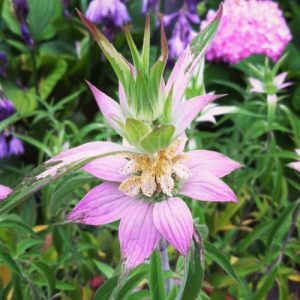Native plants in your landscape help bees and butterflies
August 19, 2017
The Spotted Bee Balm (Monarda punctata) is a plant native to Illinois that is good for bees. (Photo courtesy of Field Museum)
The past few years have seen an increase in concern for helping pollinators and other insects. To me this is the top concern for anyone who is gardening.
When I go back and look at the questions that I received over the past year or so, the majority of them have to do with creating habitat for butterflies, bumblebees and other pollinators.
Creating habitat is not a bad thing, far from it, but when I suggest that the answer to this question is native plants, I often get a look that makes me wonder if I have two heads. Native plants are a major part of the solution to creating sustainable pollinator habitats. Here are a few reason to choose native plants over any others.
1. Native plants serve as a host to a much larger number of species than non-native species. In a study done at the University of Delaware, 69 non-native plants were compared to 101 native plants. In this comparison, the 69 non-native plants served as host plants to four species of caterpillar, where the 101 native species hosted 72 species of caterpillar.
That is 18 times the number of species supported. It is estimated (conservatively) that native species play host to an average of 10 times the number of species when compared to similar non-native plants.
2. Choose Native plants even over “Native Cultivars.” Though these native cultivars may seem the same on the surface, there may be some subtle difference that will reduce the number of species that they potentially host. Steril cultivars will not produce seeds and will not support bird species that might ordinarily use the seeds as a food source.
3. Native plants are much more efficient. Native plants use water more efficiently and are adapted to the highly variable weather found in Illinois. The root system in native plants is much deeper than those of non-native plants.

Swamp Milkweed (Asclepias incarnata) is considered a good plant for those looking to build a butterfly garden.
Most native plants have root systems that extend 6 feet or more into the ground. This means that they have access to deeper water, and also increases the amount of organic material in the soil. More organic material means the soil can hold more water and has more nutrients available to the plants.
There are many ways to introduce native plants to your yard.
- Purchasing native plants from a nursery that specializes in native plants is one of the best ways to get high-quality native plants for your flower beds. When you are purchasing native plants, one thing to keep in mind is that local ecotypes of the plants are going to be the best.
A native plant that comes from Ohio is not going to be as well adapted to Illinois as one that comes from within 300 miles of your location.
- Local Native Plant Societies have native plant sales every spring. This is an excellent opportunity to get local native plants and support an organization that is promoting the use and benefits of native plants in your area.
- Purchasing native plants from your local nursery is an option to consider as well. Be careful to read the plant label when buying from a local nursery. Be sure you are purchasing a native plant and not a native cultivar. As more people request native plants for their native landscapes, these plants are becoming more common at many nurseries.
If you have any questions about native plants or natural resources, please contact Jason Haupt (jdhaupt@illinois.edu).
Jason Haupt, University of Illinois Extension Energy and Environmental Stewardship Educator, (309) 47-3711, jdhaupt@illinois.edu.
— Native plants in your landscape help bees and butterflies —



